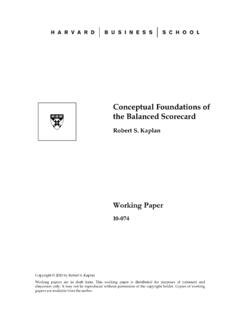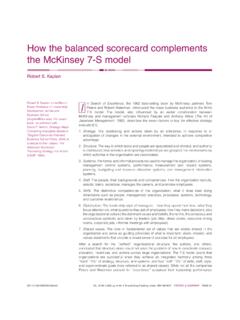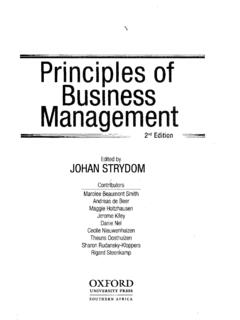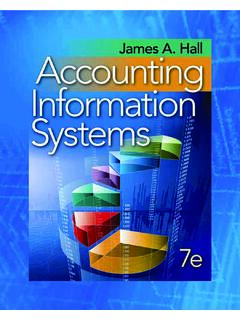Transcription of What is a Balanced Scorecard?
1 What is a Balanced scorecard ? 1 ! + # TABLE OF CONTENTS THE Balanced scorecard .. 2 The Four Perspectives .. 3 Strategic Objectives .. 5 Key Performance Indicators (KPIs) .. 7 Balanced scorecard Development .. 8 Key Features .. 10 THE KEY 13 APPENDIX 1 STRATEGY MAP .. 15 APPENDIX 2 scorecard .. 16 What is a Balanced scorecard ? 2 ! + # THE Balanced scorecard The Balanced scorecard is a framework to implement and manage strategy by linking a vision and mission to strategic priorities, objectives, measures, and initiatives. The Balanced scorecard provides a view of an organisation s overall performance.
2 It integrates financial measures with other objectives and key performance indicators related to customers, internal business processes, and organisational capacity. It was originally published by Dr Robert Kaplan and Dr David Norton as a paper1 in 1992 and then formally as a book The Balanced scorecard in 1996. Both the paper and the book spread the knowledge of the Balanced scorecard leading to its widespread success. The Balanced scorecard is not just a scorecard , it is a methodology that identifies of a small number of financial and non-financial objectives related to strategic priorities.
3 It then looks at measures, setting targets for the measures and finally strategic initiatives (often called projects). It is in this latter stage that the Balanced scorecard approach differs from other strategic methodologies. It forces an organisation to think about how objectives can be measured first and then what initiatives can be put in place to satisfy the objectives. The rationale is to avoid creating costly initiatives or projects that have no impact on the strategy. The balance that a Balanced scorecard achieves is brought about by a focus on financial and non-financial objectives that are attributed to four areas of an organisation and described as Perspectives.
4 They are: Financial, Customer, Internal Processes and Organisational Capacity. 1 It is interesting to note that although Kaplan and Norton published the first paper, they anomalously referenced work by Art Schneiderman who is believed to be the creator of the Balanced scorecard What is a Balanced scorecard ? 3 ! + # THE FOUR PERSPECTIVES Questions often arise about the four Perspectives described in the Balanced scorecard methodology. Why should we only look at Financial, Customer, Business Process and Organisational Capacity?
5 Why not include Health and Safety? The answer is, of course, there is nothing stopping us. The four perspectives are simply a framework. However, over decades of use it has become clear that they work. More importantly, there is a causal relationship between the perspectives. Working from the bottom to the top: Changes in Organisational Capacity will drive changes in Business Processes that will impact Customers and improve Financial results. If a new perspective were added, the causal relationship may not be maintained. The result might be a useful scorecard , but it would not, by definition, be a Balanced scorecard .
6 In brief, the four perspectives are: 1. Financial The high level financial objectives and financial measures of the organisation that help answer the question How do we look to our shareholders? 2. Customer Objectives and measures that are directly related to the organisations customers, focusing on customer satisfaction. To answer the question How do our customers see us? 3. Business Process Objectives and measures that determine how well the business is running and whether the products or services conform to what is required by the customers, in other words, what should we be best at?
7 4. Organisational Capacity Objectives and measures concerning how well our people perform, their skills, training, company culture, leadership and knowledge base. This area also includes infrastructure and technology. Organisational Capacity tends to be the area where most What is a Balanced scorecard ? 4 ! + # investment takes place. It answers the question: How can we improve and create value? The real value of the Perspective approach is that it provides a framework to describe a business strategy. It focuses on objectives and measures that both inform us about progress and allow us to influence activities to achieve the strategy.
8 The framework is often presented in the form of a Strategy Map, as shown above. The four perspectives are in a specific order and contain strategic objectives that contribute to a Vison and Mission. The objectives are linked in a causal way from the bottom to the top. The Strategy Map provides a very powerful tool allowing the user to talk about the causal impact of investment at the bottom to improved financial results at the top. What is interesting here is that the diagram has been created by a software tool. Software is not required to implement a Balanced scorecard , but it What is a Balanced scorecard ?
9 5 ! + # helps. Furthermore, good software tools will allow a user to drill down to the underlying data should the need arise to question a specific activity, objective or performance measure. STRATEGIC OBJECTIVES Strategic objectives turn a passive strategy into an active one. An active strategy is one that motivates and drives people to do their best while they are doing their day job. It is not an additional or separate set of activities bolted on the side or something to be done when time allows. In their book, The Institute Way, Howard Rolm and associates sum up Strategic Objectives by saying: Strategic Objectives are considered the DNA of the Balanced scorecard system They recognise that in any strategic planning process, the way to bring a strategy alive is to create meaningful Strategic Objectives.
10 Do not be fooled into thinking strategic objectives are just part of corporate strategic thinking. Strategic objectives apply to all levels of an organisation. The statements used may be different in nature, but their impact will be the same. A corporate strategic objective may be more encompassing, for example Improve Customer Satisfaction . Whereas a business unit or department level may be more specific for example Improve customer satisfaction through better customer contact . And finally, at an individual level the strategic objective may be more specific still, for example Improve customer satisfaction by spending at least 40% time on the customer site.










